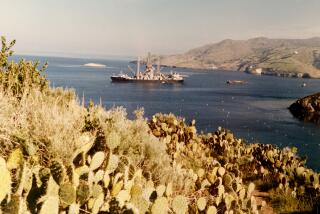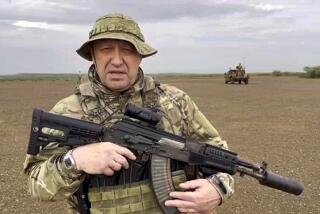CIA Gets Billing Again in Nicaragua, as Covert Action Becomes the Norm
BOSTON — Its indigo-black titanium skin begins to glow crimson as the SR-71 “Blackbird” slips through the thin air quicker than a 30.06 bullet escaping its barrel. Twenty minutes after it takes off from Beal Air Force Base near Sacramento, a faint sonic boom can be heard in San Diego as the spy plane, out over the Pacific, speeds south and then east to a secret war in Central America.
That distant boom is a subtle reminder of America’s long and opaque war against the Sandinista government of Nicaragua. In a few weeks it will be five years since President Reagan signed National Security Decision Directive 17, the secret declaration of covert war against the small Latin nation. Also in a few weeks, $100 million in U.S. aid will begin joining the more than $100 million already sent to the contra guerrillas. Perhaps even more important, the Central Intelligence Agency, benched by Congress for the past two years, will once again become a major player in the conflict.
Covert action and paramilitary operations, used occasionally by every President since Harry S. Truman, have become as institutionalized as formal state dinners under Reagan. Harbors are salted with deadly mines, assassination manuals are distributed and powerful surface-to-air missiles are supplied to rebels to shoot down Soviet aircraft. Reagan’s raiders have waged battles in Afghanistan, Angola, Cambodia, Chad, Iran, Libya and Nicaragua thus far. Reports put the budget for these secret wars at over half a billion dollars a year. Sen. Patrick J. Leahy (D-Vt.), vice chairman of the Senate Intelligence Committee, has even speculated that the contras alone may receive as much as $500 million this year, with cash supplemented from the CIA director’s secret contingency fund.
The CIA, however, is not the only employer of secret warriors. With such operations high in presidential prestige and low in bureaucratic restrictions, the Pentagon is also gearing up for more special warfare missions. This has led some, both in and out of government, to suggest that the burgeoning special operations capabilities of both the CIA and the Pentagon be combined into a new, separate agency dedicated solely to covert actions and paramilitary operations. However, this could cause more complications than it solves, because any bureaucracy tends to be self-perpetuating. Even Stansfield Turner, who, as CIA director, greatly enhanced the agency’s technical side at the expense of its covert side, nonetheless came to the conclusion that covert operations should be handled by the CIA.
Soon after the Reagan Administration came to power and the military budget was given a hefty boost, a highly secret unit named Intelligence Support Activity (ISA) was formed. It was an outgrowth of the Foreign Operating Group, which had supplied undercover agents in Tehran before the ill-fated rescue mission.
Little is known of the ISA except that in the past it has provided the Pentagon with a virtually unknown and unaccountable covert-action capability. It has apparently been used for conducting unspecified operations in El Salvador, collecting intelligence in support of the contras and supplying military equipment to foreign armies. The ISA has also been reported to have distributed, in a country that has had no diplomatic ties with the United States, arms and bulletproof vests to persons for information on military deployments. Finally, the ISA apparently also played a role in Lt. Col. James G. (Bo) Grits’ search for missing POWs in Southeast Asia and the rescue of kidnaped Maj. Gen. James L. Dozier.
In addition to the ISA, the Army has beefed up its Green Berets and reactivated its 1st Special Forces Group based at Ft. Lewis, Wash. Remembered for their role in the Vietnam War, the Army Special Forces have worked closely with the CIA on paramilitary operations since the 1950s. In 1965, a Green Beret unit was reportedly involved in a plan to assassinate the Dominican Republic’s Col. Francisco Caamano Deno, a guerrilla leader seeking to overthrow his government--but the plan was canceled at the last minute. In 1980, a group dressed as businessmen entered Tehran to collect intelligence before the rescue mission.
Two other highly secret battalions of the Army Special Forces, Delta Force and Blue Light, have been used in hostage rescue operations such as the Iranian mission and, more recently, the Achille Lauro hijacking. Still another is Task Force 160, which provides air support for Special Forces operations. According to John Prados, in his new book on covert operations, “The President’s Secret War,” members of Task Force 160, nicknamed “Night Stalkers,” wear civilian clothes while on their missions and fly an assortment of air-commando-type helicopters. Because much of their flying is done at night in support of highly classified missions, the unit has suffered an unusually high accident rate. Almost half of all aviation fatalities admitted by the army in 1983 came from Task Force 160.
The Air Force also has a separate air support unit for special operations, known as the Special Operation Wing, with five squadrons and a helicopter detachment and the navy has its Naval Special Warfare and Sea, Air, Land Teams.
As was seen in the Iranian hostage rescue mission and the invasion of Grenada, this caldron of separate clandestine and special warfare units can prove to be disastrous. In Grenada, the Delta unit, assigned to clear the runway, was pinned down by Cuban soldiers as soon as it landed, thereby forcing the Army Rangers to parachute in. According to one report, it is estimated that more than half of the Delta troopers were wounded or killed before Rangers could drive off the Cubans. Other mishaps befell the air assault by Task Force 160 and the sea assault by the Navy SEAL teams.
Lack of coordination is not the only problem faced by the Pentagon’s secret warriors. Inadequate oversight has led to massive financial scandals in both the Delta unit and the Intelligence Support Activity. According to one report, more than 80 members of the Army’s Delta force received disciplinary action following an internal investigation. Another investigation of the ISA turned up such elaborate unauthorized purchases as a Rolls-Royce and a hot-air balloon.
To bring some centralization to the Pentagon’s special warfare forces, consisting of about 15,000 people and a budget of roughly $1.2 billion, the Pentagon created the Joint Special Operations Agency in early 1984. While the organization, responsible to the Joint Chiefs of Staff, is charged with coordinating such activities as training and strategic planning, it does not have any command functions. As a result, a number of observers have suggested total reorganization of not only the Pentagon’s special operations but also the CIA’s covert actions. The readiness subcommittee of the House Armed Services Committee, for example, proposed the creation of a Defense special operations agency which would be patterned after the National Security Agency. Under this proposal, the new agency, with a civilian director and a military deputy, would control the financing, training and deployment of the Special Forces.
Others would go even further, suggesting that the Pentagon give up the cumbersome mission and turn it over to the CIA. Prados, in his book, takes the opposite position. He argues that the CIA should give up its covert action function and turn it over to the Pentagon. “This would ensure maintenance of the capability for wartime,” he writes, “when it has been demonstrated historically to be most effective, and reduce the propensity to use this technique against the Third World in the service of some Cold War strategy.” He also argues that such a move would clarify the legal status of paramilitary action since the authority of the CIA to conduct such operations has always been ambiguous. It would also allow the CIA to concentrate on what it was originally set up to do: collect intelligence.
As the Reagan Administration continues to discover new governments to topple and brush wars to fight, America will have to live not only with a Cold War but also a hot peace.
More to Read
Sign up for Essential California
The most important California stories and recommendations in your inbox every morning.
You may occasionally receive promotional content from the Los Angeles Times.










